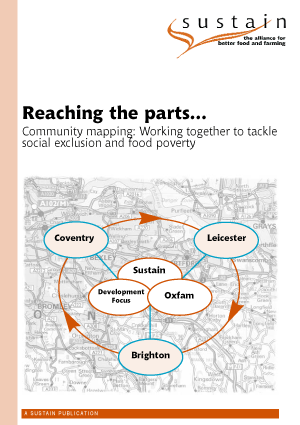Reaching the Parts... Community mapping: Working together to tackle social exclusion and food poverty
Community Mapping uses participatory appraisal methods to enable local people to analyse their food economies and work with others to develop sustainable solutions to the problems they face in eating a healthy diet.
This full colour report illustrates the process and findings of the pilot projects in Brighton, Coventry and Leicester. It concludes with a range of recommendations to help tackle food poverty and increase people’s control over their communities.
Report contents
Summary
1. Introduction
- The Community Mapping Project
- Participatory Appraisal
- Differences and similarities, compared to other approaches
- The pilot projects: Why we did what we did
- Who "we" are
- Why we did it
- What we did
- The purpose of this report
2. The Community Mapping Project in Brighton, Coventry and Leciester
- Brighton - Community Mapping in Hollingdean
- Coventry - Food for Life in Foleshill
- Leicester - Nosh ‘n’ Dosh in Braunstone
3. What we learnt
- Use plenty of different places and methods, and enjoy experimenting!
- Places
- Methods
- Involve everyone, expect diversity (but be clear about responsibilities)
- Involve everyone
- Expect diversity
- Clarify responsibilities
- Be flexible and realistic
- Flexibility
- Realism
- Allow plenty of time and money
- Check, check and check again (and keep good records)
- Protect people’s privacy
- Get everyone’s commitment to the process and the results
4. Reason for recommending community mapping
- It enhances skills and confidence
- It reaches the parts other methods don’t reach
- It provides – immediately – plenty of high quality information (and not just about food)
- Food and children
- Transport
- Money
- Quality of the shops
- Places to eat and meet socially
- Time and facilities
- Knowledge and skills
- It leads to creative action
- It contributes to, and can be integrated with other initiatives to improve an area
5. Conclusions and recommendations
- Where to find out more

Reaching the Parts... Community mapping: Working together to tackle social exclusion and food poverty
ISBN: 1 903060 12 5 - 86pp - 2000 | 3200Kb
Published Tuesday 1 January 2002
Food Poverty: Millions of people in the UK struggle to get enough to eat. We’re working to change that through people-powered projects and campaigns that tackle the root causes of food poverty and ensure everyone has dignified access to healthy, affordable food.